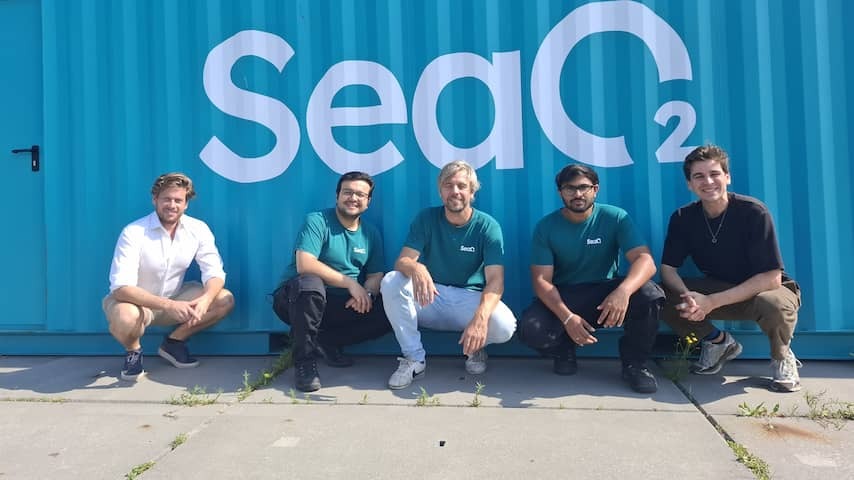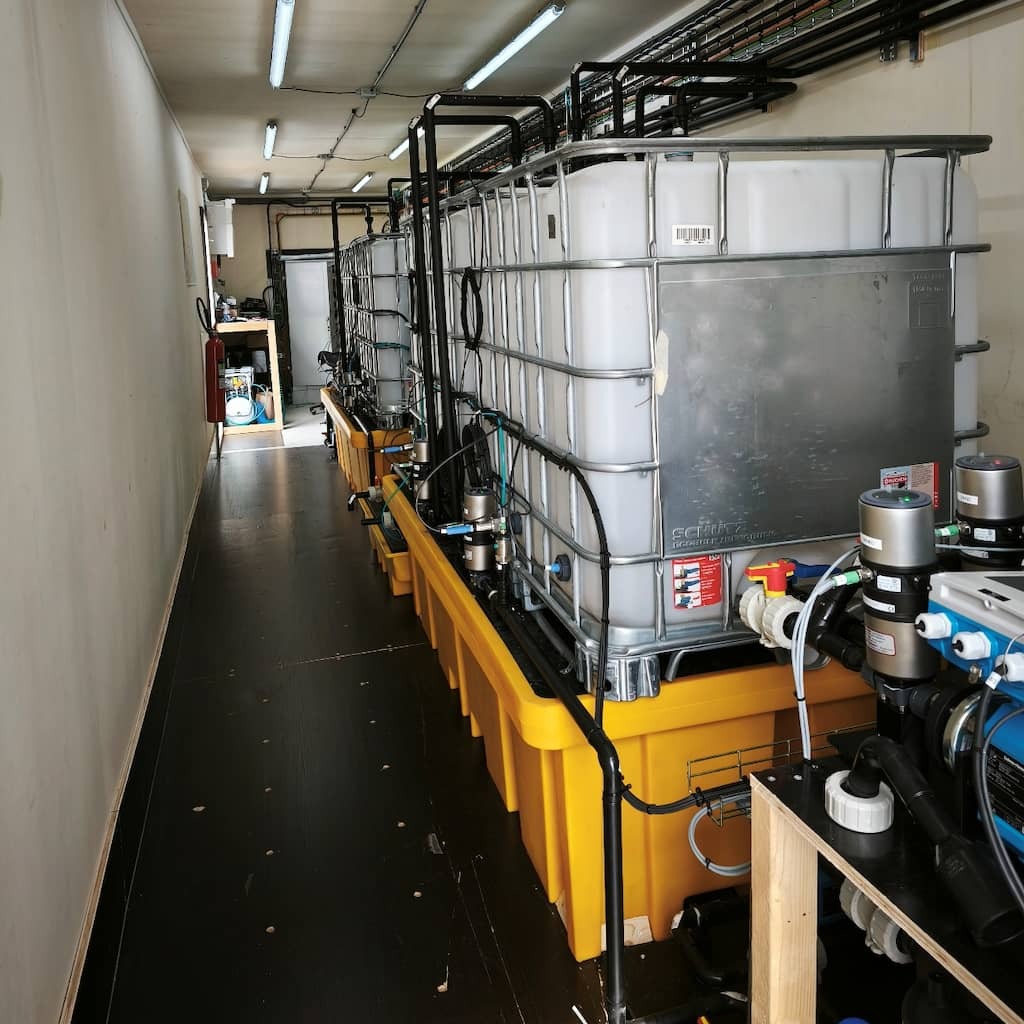
In the Koplopers series, NU.nl visits projects this summer that give a glimpse into the sustainable future. This week: the start-up that CO2 wants to get from seawater to prevent climate change.
There are not many people who can say that they work in the middle of the Afsluitdijk, but Thijs Meijssen is one of them. He is Chief Science Officer at Seao2, which is sandwiched between the A7 and the Fryslân wind farm on the IJsselmeer. You can relax on a sunny summer afternoon. “But in the winter you sometimes don’t get the door closed by the wind,” laughs Meijssen.
Seao2 is part of a growing landscape of companies that work on ‘carbon removal’. To prevent climate change, our CO2 emissions must first of all be reduced. But we may also be able to prevent warming – or eventually even turning back a little – by removing CO2 from the sky. Certainly now that the climate goals from the Paris Agreement seem to be unfeasible, more and more attention is being paid to this concept.
It’s just not easy. Companies that want to get CO2 out of the air must look for a pin in a haystack: there are only 425 CO2 molecules in a million air particles. You therefore have to pump a lot of air through a fan to remove a kilo of CO2.
That is why it is smarter to remove that CO2 from the sea, thinks Seao2. A third of all CO2 that we emit resolve in the ocean. And the CO2 concentration is a lot higher. Yet around 10,000 liters of seawater is still needed to remove one kilo CO2. An average Dutchman provides 9,000 kilos of CO2 emissions per year, so the amount of seawater that you have to pump to really put on is enormous.
Seao2 therefore hope to collaborate with companies that are already pumping up a lot of seawater, for example to cool power plants. According to Meijssen, a drill platform at sea would also be a logical place to apply the technology.
Not as simple as cola
That is all still in the future. Now Seao2 still gets a relatively small amount of water from the Wadden Sea, which then goes through a complex process. On a whiteboard, Meijssen outlines what happens: the seawater is filtered and then led by a membrane. With a chemical trick, the water is separated there into two streams: sour and basic.
The acid is added to a separate tank of seawater. It ensures that the CO2 changes shape, so that you can remove it from the water with a vacuum pump. A bit like carbon dioxide from the cola bubbles. “But it is less aggressive than in a coke lesson,” says Meijssen. “It would be Chill if it was that easy.”
In addition to the workspace of SEAO2, a truck has just delivered a large part of the Testefabriek that the company will use this year. The complex Wirwar from tubes, pumps and water tanks must soon be able to get 25 tons of CO2 per year from seawater. A limited amount, but this factory is therefore primarily intended to test and further develop the technology.
In the coming years, SEAO2 hopes to grow strongly, with a goal as a goal to get no less than a billion tons of CO2 from the world’s seas in 2045. That is almost 2 percent of current global emissions. The CO2 must then be stored underground or used in products such as sustainable aviation fuel.
“Then you have to think of several very large factories,” says Meijssen. They must be in places where a lot of cheap and sustainable energy is available, because a lot of electricity is needed to remove CO2 from the water. In the end, SEAO2 hopes to be able to remove a ton of CO2 with 1,500 kilowatt hours of electricity: still more than half of the annual consumption of one household.
“We are not there yet,” says director Ruben Brands. “But we try to work with different measures.”
Reverse ocean acidification
If it is indeed possible to harvest large -scale CO2, the SEAO2 factories would let a large stream of water without CO2 run back to the ocean. What does that do with nature? “I have to say it a bit carefully, but we think it can have positive effects,” says Meijssen. “Because the ocean actually acidifies due to an excess of CO2.”
Seao2 thinks that it can turn that process a little bit. Meijssen emphasizes that Seao2 does not use chemicals, so all the seawater – apart from the removed CO2 – comes back to the sea. The exact impact on nature still has to be done if the technology is applied on a larger scale.
Before the time comes, Seao2 will first move to the port of Scheveningen. Then the start-up must look for tens of millions in growth, after an amount of 2 million euros has already been raised. “The preparations for that are running,” says Meijssen. He is not worried about the trust of investors. “So far we have not heard ‘no’.”
In The Series Koplopers, NU.nl Visits Projects This Summer That Offer A Glimpse Into The Sustainable Future. This week: The start-up that wags to extract CO2 from Seawater to Combat Climate Change.
There are not many people who can say work in the middle of the afsluitdijk, but Thijs Meijssen is one of them. He is Chief Science Officer at Seao2, which is Between the A7 and the Windpark Fryslân on the IJsselmeer. On a Sunny Summer Afternoon it is a good place to be. “But in the winter you sometimes can’t get the by closed because of the wind,” Meijssen Laughs.
Seao2 is Part of a Growing Landscape of Companies Working on ‘Carbon Removal’. To Combat Climate Change, our CO2 Emissions Must First Be Reduced. But we may also be able to counteract global warming – or just reverse it a little in the end – by extracting CO2 from the air. ESpeciate now that the climate goals from the paris agreement seem unattainable, there is Increasing Attention for this concept.
It’s not easy. Companies that because to extract CO2 from the air have to look for a needle in a haystack: there are only 425 CO2 molecules in a Million Air Particians. You Therefore Have To Pump An Huge Amount of Air Through A Fan To Remove A Kilo of CO2.
That is why it is emarter to extract that co2 from the sea, seao2 thinks. A third of all co2 that we emit dissolves in the ocean. And the CO2 concentration is a lot Higher there. Yet There is Still around 10,000 liters of Seawater Needed to Remove One Kilo or CO2. An Average Dutchman Causes 9,000 kilos of CO2 Emissions per year, So the Amount of Seawater You have to Pump up to Really Make A Difference is huge.
Seao2 Therefore Hopes to Work Together with Companies That Already Pump Up A Lot Of Seawater, For Example to Cool Power Plants. Accordance to Meijssen, an Drilling Platform at Sea would also be a logical place to Apply the Technology.

Not as simple as cola
That is all in the future. SEAO2 NOW Extracts A Relatively Small Amount of Water from the Wadden Sea, which Goes Through a Complex Process. Meijssen Sketches What Happens On A Whiteboard: The Seawater is filtered and then passed through a membrane. With a chemical trick, the water is separated there into two streams: acidic and basic.
The Acid is added to a separate tank or seawater. It ensures that the co2 changes shape, so that you can extract it from the water with a vacuum pump. A Bit Like Carbonic Acid Bubbles Out of Cola. “But it is less aggressive than in a cola bottle,” Says Meijssen. “It would be chill if it was that easy.”
Next to the SEAO2 Workspace, A Truck Has Just Delivered a Large Part of the Pilot Plant that the Company Will Be Using This Year. The complex Tangle of Pipes, Pumps and Water Tanks Must Soon Be Able to Extract 25 Tons of CO2 per year from Seawater. A Limited Amount, But This Factory is Primarily Intended to Test and Further Develop the Technology.
In The Coming Years, Seao2 Hopes to Grow Strongly, With A Long-Term Goal of Extracting As Much As One Billion Tons of CO2 From the World’s Oceans by 2045. That is Almost 2 percent of Current Global Emissions. The CO2 Must then Stored Underground or Used in Products Such As Sustainable Aviation Fuel.
“Then you have to think of several very large factories,” Says Meijssen. These must be locationed in places where there is a lot of cheap and sustainable energy available, because a lot of electricity is needed to extract CO2 from the water. Ultimately, SEAO2 Hopes to Be Able to Remove One Ton or CO2 with 1,500 Kilowatt Hours of Electricity: Still More Than Half of the Annual Consumption of One Household.
“We’re not there yet,” Says director Ruben Brands. “But we are trying to work TOWARDS that with Various Measures.”
Reversing Ocean Acidification
If it does Succed in Harvesting CO2 on a Large Scale, Seao2’s factories would Let a Large Stream of Water without CO2 Flow Back Into The Ocean. What does that do to nature? “I have to say it a bit carefully, but we think it can have positive effects,” Says Meijssen. “Because the ocean is acidifying due to an excess of CO2.”
SEAO2 Thinks it can reverse that process a little bit. Meijssen Emphasizes That Seao2 Does Not Use Chemicals, So All The Seawater – Apart from the Removed CO2 – Comes Back Into The Sea Untouched. Further Research Still Needs to Be Done Into The Exact Impact On Nature The Technique is Applied On A Larger Scale.
Before That Happens, Seao2 Will First Move to the Port of Scheveningen. Then the start-up has to look for tens of millions in Growth Capital, after an amount or 2 million euros was raised Earlier. “The preparations for this are underway,” Says Meijssen. He is not worried about the Confidence of Investors. “So far we have not heard a ‘no’.”